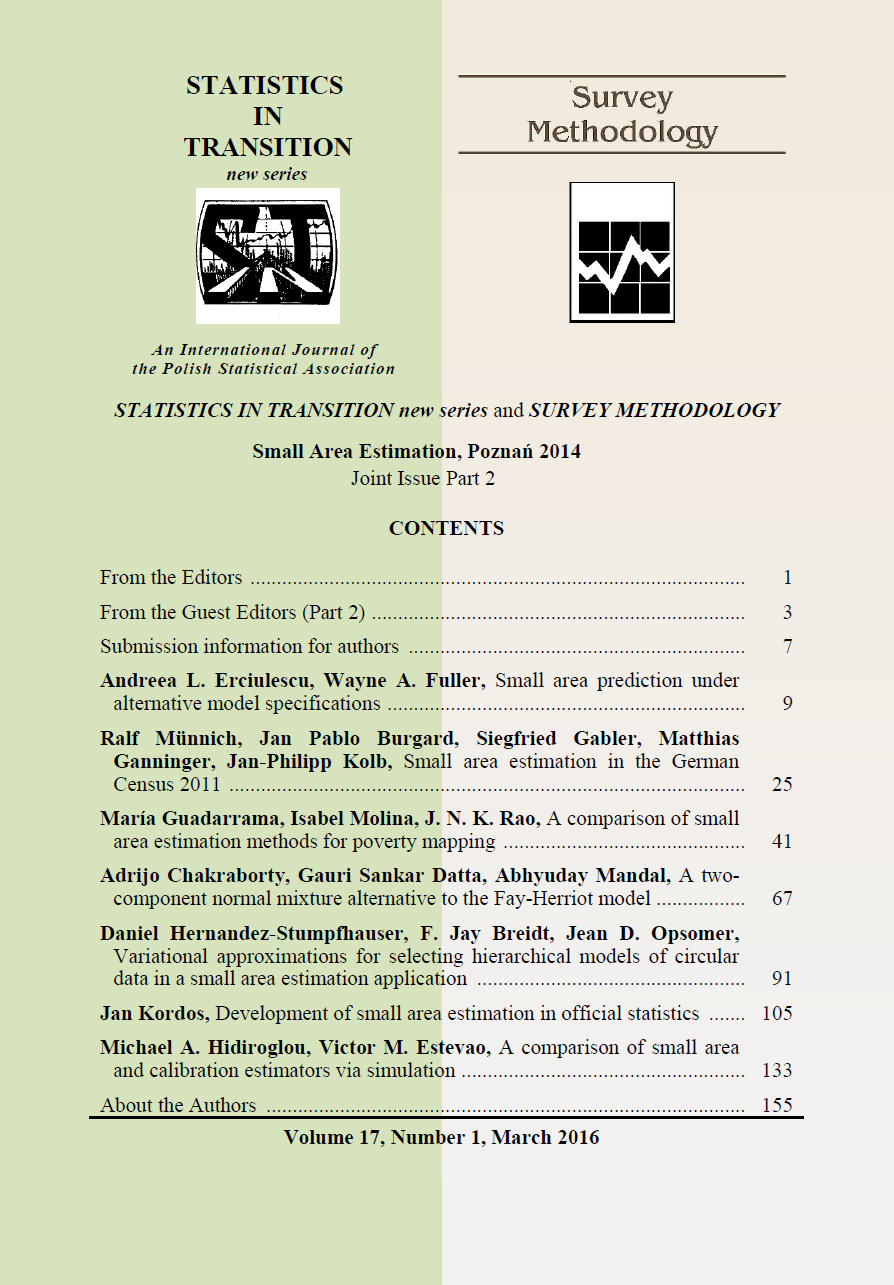ARTICLE
ABSTRACT
This article considers a robust hierarchical Bayesian approach to deal with random effects of small area means when some of these effects assume extreme values, resulting in outliers. In the presence of outliers, the standard Fay-Herriot model, used for modeling area-level data, under normality assumptions of random effects may overestimate the random effects variance, thus providing less than ideal shrinkage towards the synthetic regression predictions and inhibiting the borrowing of information. Even a small number of substantive outliers of random effects results in a large estimate of the random effects variance in the Fay-Herriot model, thereby achieving little shrinkage to the synthetic part of the model or little reduction in the posterior variance associated with the regular Bayes estimator for any of the small areas. While the scale mixture of normal distributions with a known mixing distribution for the random effects has been found to be effective in the presence of outliers, the solution depends on the mixing distribution. As a possible alternative solution to the problem, a two-component normal mixture model has been proposed, based on non-informative priors on the model variance parameters, regression coefficients and the mixing probability. Data analysis and simulation studies based on real, simulated and synthetic data show an advantage of the proposed method over the standard Bayesian Fay-Herriot solution derived under normality of random effects
KEYWORDS
Hierarchical Bayes, heavy-tail distribution, non-informative priors, robustness to outliers; small area estimation.
REFERENCES
ANGERS, J. F., BERGER, J. O., (1991). Robust hierarchical Bayes estima tion of exchangeable means. Canadian Journal of Statistics, 19, 39–56.
BELL, W. R., HUANG, E. T., (2006). Using t-distribution to deal with out liers in small area estimation. Proceedings of Statistics Canada Synposium 2006 Methodological issues in measuring population health.
BERGER, J. O., (1984). The robust Bayesian viewpoint (with discussion). In Robustness of Bayesian Analysis, Ed.: J. Kadane, North-Holland, Amster dam.
CHAMBERS, R., CHANDRA, H., SALVATI, N., TZAVIDIS, N., (2014). Outlier robust small area estimation. Journal of the Royal Statistical Society, Series B:, 76, 47–69.
DATTA, G. S., (2009). Model-based approach to small area estimation. Hand book of Statistics: Sample Surveys: Inference and Analysis, 29B, Eds.: D. Pfeffermann and C. R. Rao, The Netherlands: North-Holland. 251–288.
DATTA, G. S., GHOSH, M., (2012). Small area shrinkage estimation. Statis tical Science, 27, 95–114.
DATTA, G. S., HALL, P. G., MANDAL, A., (2011). Model selection by testing for the presence of small-area effects in area-level data. Journal of the American Statistical Association, 106, 362–374.
DATTA, G. S., LAHIRI, P., (1995). Robust hierarchical Bayesian estimation of small area characteristics in presence of covariates and outliers. Journal of Multivariate Analysis, 54, 310–328.
DATTA, G. S., MANDAL, A., (2015). Small area estimation with uncertain random effects. To appear in Journal of the American Statistical Association, 110, DOI: 10.1080/01621459.2015.1016526.
DATTA, G. S., RAO, J. N. K., SMITH, D., (2005). On measuring the vari ability of small area estimators under a basic area level model. Biometrika, 92, 183–196.
DEY, D. K., BERGER, J. O., (1983). On truncation of shrinkage estimators in simultaneous estimation of normal means. Journal of the American Statistical Association, 78, 865–869.
EFRON, B., MORRIS, C., (1971). Limiting the risk of Bayes and empirical Bayes estimators, Part I: The Bayes Case. Journal of the American Statistical Association, 67, 130–139.
FAY, R. E., HERRIOT, R. A., (1979). Estimates of income for small places: an application of James-Stein procedures to census data. Journal of the Amer ican Statistical Association, 74, 269-277.
GHOSH, M., RAO, J. N. K., (1994). Small area estimation: an appraisal. Statistical Science, 9, 55–93.
GHOSH, M., MAITI, T., ROY, A., (2008). Influence functions and robust Bayes and empirical Bayes small area estimation. Biometrika, 95, 573–585.
JIANG, J., LAHIRI, P., (2006). Mixed model prediction and small area esti mation. Test, 15, 1–96.
PFEFFERMANN, D., (2013). New important developments in small area estimation. Statistical Science, 28, 40–68.
PRASAD, N. G. N., RAO, J. N. K., (1990). The estimation of the mean squared error of small-area estimators. Journal of the American Statistical Association, 85, 163–171.
RAO, J. N. K., (2003). Small Area Estimation. Wiley-Interscience, Hoboken, NJ.
RAO, J. N. K., (2011). Impact of frequentist and Bayesian methods on survey sampling practice: a selective appraisal. Statistical Science, 26, 240–256.
SCOTT, J. G., BERGER, J. O., (2006). An exploration of aspects of Bayesian multiple testing. Journal of Statistical Planning and Inference, 136, 2144–2162.
SINHA, S. K., RAO, J. N. K., (2009). Robust small area estimation. The Canadian Journal of Statistics, 37, 381–399.
STEIN, C. M., (1956). Inadmissibility of the usual estimator for the mean of a multivariate normal distribution. Proceedings of the Third Berkeley Symposium on Mathematical Statistics and Probability 1954–1955, I, 197-206. Univ. California Press, Berkeley.
STEIN, C. M., (1981). Estimation of the mean of a multivariate normal dis tribution. Annals of Statistics, 9, 1135–1151.
XIE, D., RAGHUNATHAN, T. E., LEPKOWSKI, J. M., (2007). Estimation of the proportion of overweight individuals in small areas - a robust extension of the Fay-Herriot model. Statistics in Medicine, 26, 2699–2715
